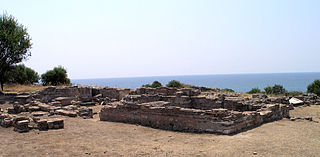
The first recorded bishop of Tarsus, Helenus, went to Antioch several times in connection with the dispute concerning Paul of Samosata. Le Quien mentions twenty-two of its bishops, of whom several are legendary.
Germanicopolis was an ancient town in Bithynia, also known as Caesarea in Bythinia (not to be confused with Caesarea Germanica, as such a former bishopric and present Latin Catholic titular see.
Hebron was an episcopal see during the Crusader period.
Porphyreon was a town in the late Roman province of Phoenice Prima, and a bishopric that was a suffragan of the metropolitan see of that province, Tyre. It corresponds to present-day Jieh, Lebanon.
Caloe was a town in the Roman province of Asia. It is mentioned as Kaloe or Keloue in 3rd-century inscriptions; as Kalose in Hierocles's Synecdemos (660); and as Kalloe, Kaloe, and Kolone in Parthey's Notitiæ episcopatuum, in which it figures from the 6th to the 12fth or 13th century.
Cestrus was a city in the Roman province of Isauria, in Asia Minor. Its placing within Isauria is given by Hierocles, Georgius Cyprius, and Parthey's. While recognizing what the ancient sources said, Le Quien supposed that the town, whose site has not been identified, took its name from the River Cestros and was thus in Pamphylia. Following Lequien's hypothesis, the 19th-century annual publication Gerarchia cattolica identified the town with "Ak-Sou", which Sophrone Pétridès called an odd mistake, since this is the name of the River Cestros, not of a city.
Eudoxias was a city and bishopric in the late Roman province of Galatia Secunda, in Asia Minor.
Hauara was an ancient episcopal see in Palestina Tertia, a suffragan of Petra.
Hephæstus was a town in Roman Egypt, in the province of Augustamnica Prima, the eastern part of the Nile Delta.

Polystylus is the name of an ancient town and bishopric in the late Roman province of Macedonia Secunda, whose metropolis was Philippi. Its name is given in this form in the Catholic Church's list of titular sees. A 1911 article by Sophrone Pétridès called it Polystylum.
Trapezopolis or Trapezoupolis (Τραπεζούπολις) was a city of ancient Caria, and later in the late Roman province of Phrygia Pacatiana Prima.
The Metropolis of Thebes and Livadeia is a metropolitan see of the Church of Greece in Boeotia, Greece. Since the Middle Ages it has also existed as a Roman Catholic titular see. The current metropolitan is Georgios Mantzouranis.
Acarassus or Akarassos was a city in ancient Lycia.

The Diocese of Laodicea in Phrygia, is an important Titular Christian Diocese, centered on the biblical city of Laodicea on the Lycus in modern Turkey. The Church at Laodicea was a centre of Christianity from a very early point. The New Testament indicates a Christian presence in Laodicea as early as the AD 50s. The church is mentioned extensively in the epistle to the Colossians, and the First Epistle to Timothy may have been written here. Further, the church was one of the Seven churches of Asia. A bishop was appointed in Apostolic Times, with numerous suffragan bishop attached.
Eudocia was a town in ancient Lycia.
Meloë was a town in ancient Lycia, located near Cape Kilidonia.

Tracula is a former Ancient city and bishopric in Asia Minor, which remains a Latin Catholic titular see.

Justinianopolis in Armenia also known as Iustinianopolis was a Roman and Byzantine era city and bishopric in Lesser Armenia. It has been identified with modern Erzincan, Turkey. It was one of several ancient sites renamed in late Antiquity after Byzantine emperor Justinian I. The city also known as Acilisene and Keltzene.
The Holy Metropolis of Tricca, Gardiki and Pyli, is a metropolis under the jurisdiction of the Church of Greece. The metropolis is centered on the cities of Trikala and Kalabaka located in Thessaly, in central Greece.
The Latin or Roman Catholic Archbishopric of Neopatras is a titular see of the Catholic Church. It was established briefly as a residential episcopal see at Neopatras in Central Greece, after the Fourth Crusade, in place of the Greek Orthodox Metropolis of Neopatras. The area was recovered by the Epirote Greeks in c. 1218, but came again under Latin rule in 1319 as the Duchy of Neopatras, leading to the restoration of the see until the Ottoman conquest. The archbishopric was restored as a titular see in 1933. Its last incumbent died in 1967.







